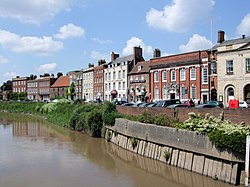Wisbech
| Wisbech | |
| Cambridgeshire | |
|---|---|
 North Brink | |
| Location | |
| Grid reference: | TF4609 |
| Location: | 52°39’-0"N, -0°9’0"E |
| Data | |
| Population: | 20,200 ((2001)) |
| Post town: | Wisbech |
| Postcode: | PE13-14 |
| Dialling code: | 01945 |
| Local Government | |
| Council: | Fenland |
| Parliamentary constituency: |
North East Cambridgeshire |
Wisbech (pron. Wiz-beach) is a market town and inland port with a population of about 20,000 in the very north of Cambridgeshire. The tidal River Nene runs through the centre of the town and is spanned by two bridges. The name is believed to mean on the back of the (River) Ouse.
The town was formerly a prosperous port, as ships could enter the Wisbech on the river. The port business has now largely moved upstream.
Wisbech is noted for its unspoilt Georgian architecture, particularly along North Brink and The Crescent; a legacy of its wealthy past. It has therefore attracted the filming of costume dramas.
Every summer a "Rose Fair" is held in St Peter's Church. The church is decorated with floral displays sponsored by local organisations and businesses. A parade of floats forms up in Queens Road and circuits the town. Strawberry and cream teas are served and stalls raise funds for local charities. Coaches bring visitors from a wide area. Details are available from the local tourist office.
History
Wisbech Castle was built in 1086 by William I to fortify the town, and in later Tudor times it became a notorious prison. Among those held there were John Feckenham, the last Abbot of Westminster and two of the key participants in the Gunpowder Plot, Robert Catesby and Francis Tresham. The castle was rebuilt in the mid-17th century, and again in 1816 by Joseph Medworth, who also developed The Crescent, familiar as the setting in numerous costume dramas.
The major town dwelling is Peckover House with its fine walled garden, built for the Quaker banking family in 1722 and now owned by the National Trust.
In the 17th century, the local inhabitants became known as the "Fen Tigers" because of their resistance to the draining of the fens, but the project turned Wisbech into a wealthy port handling agricultural produce. At this time Wisbech was on the estuary of the River Ouse, but silting caused the coastline to move north, and the River Nene was diverted to serve the town. The Wisbech Canal joining the River Nene at Wisbech was subsequently filled in and became the dual carriageway leading into the town from the east (now crossing the bypass).
Notable buildings
- Peckover House (1722; owned by the National Trust)
- Clarkson Memorial (1881)
- St Peter and St Paul's Parish Church
- St Mary's Parish church
- Octavia Hill Birthplace Museum
- Wisbech Museum; extensive collections of local records and other items. [1]
- Elgood's Brewery (founded in 1795)
Further reading
- Dorothy Thurman, with illustrations by Derek Abel (1998). Wisbech. The Wisbech Society and Preservation Trust Ltd.. ISBN 0-9519220-5-X.
References
- ↑ Notable artefacts in the Wisbech Museum include: Napoleon's Sèvres breakfast service, said to have been captured at the Battle of Waterloo; Thomas Clarkson's chest, containing examples of 18th century African textiles, seeds and leatherwork which he used to illustrate his case for direct trade with Africa; and the original manuscript of Charles Dickens' Great Expectations.
Outside links
- Wisbech Town Cricket Club
- River Nene through Wisbech, from source to mouth.
- Fenland Citizen Web site of local newspaper
- Fenland District Council District councils web site
- The Wisbech Society & Preservation Trust